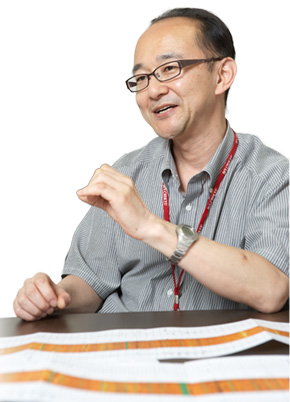An operation that must not fail
 Saneatsu Saito
Saneatsu Saito
Principal Research Scientist Institute for Research on Earth Evolution (IFREE) Japan Agency for Marine-Earth Science and Technology (JAMSTEC)
While persevering in the face of bad weather and equipment failures, drilling, with various sensors fit to the drill bit, on-board the CHIKYU started on 21 April. The strata in the borehole are investigated during the drilling process: this is called Logging While Drilling (LWD).
The data collected during LWD this time concerned borehole wall electric resistivity and natural gamma rays.
Electrical resistivity is affected by the water content in the rock. In a fault, we expect the rock to have been fractured. Water will seep into cracks of the fractured rock. This water causes electric resistivity to drop (electricity will run through it more easily). Natural gamma rays on the other hand are emitted by clay minerals which are thought to form the fault zones.
These data have enabled us for the first time to determine the depth of the fault with a high level of accuracy. That is something which is essential both when collecting geological samples from the fault as when installing temperature sensors. Says Saneatsu Saito of the LWD Team: “So this was an operation where it was imperative that the LWD be successful.”
At the start of LWD, data are displayed on the monitor aboard the ship almost in real time, at intervals of approximately 1 meter every two minutes. At first, lots of people assembled in front of the monitor, attracted by the curiosity of the data. These are, however, only shown once every two minutes. When changes in the data couldn’t really be seen the crowd assembled at the monitor gradually thinned, leaving only the staff on duty in the end.
On the second day after the start of LWD, a change emerged in the data. Standing out in a different place to before, some data were displayed.
“If it happens once there is the possibility that it is just noise. It was tantalizing, because data only appear once every two minutes,” Saito tells. As time went by, a clear trend appeared on the screen.
The electric resistivity dropped, and the natural gamma ray figure started to rise. “I thought ‘Yes! There it is!’” (Saito). They had reached the clay layer with the fault.
When they had passed through the 15m thick layer of clay, electric resistivity rose again at once. They had reached the layer of hard rock called chert, which forms the upper part of the Pacific Plate. “This is a great success. We have hardly ever seen such beautiful LWD data before.” (Saito) The drilling at this time reached at the water depth of 6,889.5m plus a subseafloor depth of 850.5m.


